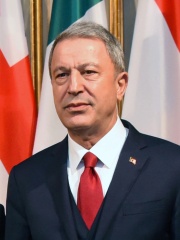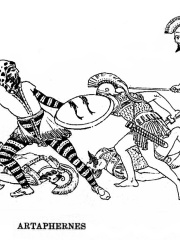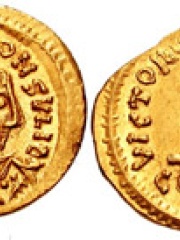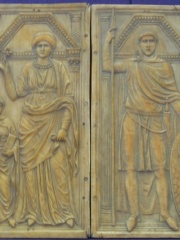
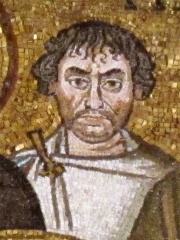
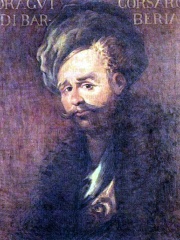
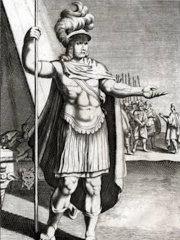
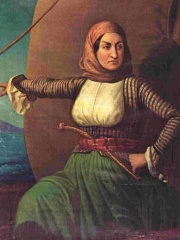
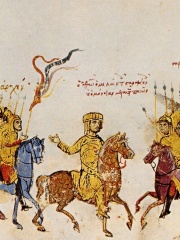
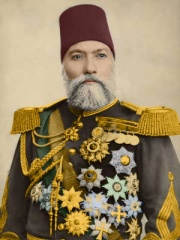

The Most Famous
MILITARY PERSONNELS from Türkiye
This page contains a list of the greatest Turkish Military Personnels. The pantheon dataset contains 2,058 Military Personnels, 38 of which were born in Türkiye. This makes Türkiye the birth place of the 12th most number of Military Personnels behind Greece, and Italy.
Top 10
The following people are considered by Pantheon to be the top 10 most legendary Turkish Military Personnels of all time. This list of famous Turkish Military Personnels is sorted by HPI (Historical Popularity Index), a metric that aggregates information on a biography's online popularity. Visit the rankings page to view the entire list of Turkish Military Personnels.

1. Stilicho (359 - 408)
With an HPI of 74.22, Stilicho is the most famous Turkish Military Personnel. His biography has been translated into 51 different languages on wikipedia.
Stilicho (; c. 359 – 22 August 408) was a military commander in the Roman army who, for a time, became the most powerful man in the Western Roman Empire. He was partly of Vandal origins and married to Serena, the niece of emperor Theodosius I. He became guardian for the underage Honorius. After years of struggle against barbarian and Roman enemies, political and military disasters finally allowed his enemies in the court of Honorius to remove him from power. His fall culminated in his arrest and execution in 408.

2. Narses (478 - 574)
With an HPI of 74.06, Narses is the 2nd most famous Turkish Military Personnel. His biography has been translated into 42 different languages.
Narses (also spelled Nerses; Latin pronunciation: [ˈnarseːs]; Armenian: Ներսէս; Greek: Ναρσής; c. 478–573) was a distinguished Roman general and statesman of Armenian heritage, renowned for his critical role in Emperor Justinian I’s military campaigns. Alongside the famed Belisarius, Narses was instrumental in the reconquest of Italy during the Gothic War (535–554), which sought to restore the western provinces of the Roman Empire. Narses first gained significant recognition by suppressing the Nika riots in 532, using his diplomatic skills and wealth to help quell the revolt. His later campaigns in Italy were marked by decisive victories, most notably at the Battle of Taginae in 552, where he defeated the Ostrogothic king Totila, and at the Battle of Mons Lactarius in 553, effectively ending the Ostrogothic kingdom.

3. Dragut (1485 - 1565)
With an HPI of 73.33, Dragut is the 3rd most famous Turkish Military Personnel. His biography has been translated into 33 different languages.
Dragut (Turkish: Turgut Reis; 1485 – 23 June 1565) was an Ottoman corsair, naval commander, governor, and noble. Under his command, the Ottoman Empire's maritime power was extended across North Africa. Recognized for his military genius, and as being among "the most dangerous" of corsairs, Dragut has been referred to as "the greatest pirate warrior of all time", "undoubtedly the most able of all the Turkish leaders", and "the uncrowned king of the Mediterranean". He was nicknamed "the Drawn Sword of Islam". He was described by a French admiral as "a living chart of the Mediterranean, skillful enough on land to be compared to the finest generals of the time" and that "no one was more worthy than he to bear the name of king". Hayreddin Barbarossa, who was his mentor, stated that Dragut was ahead of him "both in fishing and bravery". In addition to serving as Admiral and Corsair in the Ottoman Empire's Navy under Suleiman the Magnificent, Dragut was also appointed Bey of Algiers and Djerba, Beylerbey of the Mediterranean, as well as Bey, and subsequently Pasha, of Tripoli. While serving as Pasha of Tripoli, Dragut built up and adorned the city, making it one of the most impressive to behold along the entire North African coast.

4. Eumenes (362 BC - 316 BC)
With an HPI of 70.85, Eumenes is the 4th most famous Turkish Military Personnel. His biography has been translated into 36 different languages.
Eumenes (; Ancient Greek: Εὐμένης; fl. 361–315 BC) was a Greek general, satrap, and Successor of Alexander the Great. He participated in the Wars of Alexander the Great, serving as Alexander's personal secretary and later on as a battlefield commander. Eumenes depicted himself as a lifelong loyalist of Alexander's dynasty and championed the cause of the Macedonian Argead royal house. In the Wars of the Diadochi after Alexander's death, Eumenes initially supported the regent Perdiccas in the First Diadochi War, and later the Argead royalty in the Second Diadochi War. Despite less experience as a commander, Eumenes defeated Craterus, one of Alexander's most accomplished generals, at the Battle of the Hellespont in 321 BC. After Perdiccas' murder in 320 BC Eumenes became a public enemy of the new Post-Alexander regime under Antipater and Antigonus. In 319 BC he was defeated by Antigonus at the Battle of Orkynia and confined to Nora. Eumenes escaped and then allied with Polyperchon and Olympias, Alexander's mother, against Cassander and Antigonus. From 318 BC onward he led a hard-fought campaign against Antigonus, defeating him at the Battle of Paraitakene, then being indecisively defeated later at the Battle of Gabiene. Afterward, Eumenes was betrayed by his soldiers (the Silver Shields) and given over to Antigonus. Antigonus executed him in the winter of 316–315 BC. The Greek biographer and essayist Plutarch chose Eumenes as the focus of one of his biographies in Parallel Lives, where he was paired with Quintus Sertorius, the rebel Roman general who led a revolt against Rome in the 70s BC.
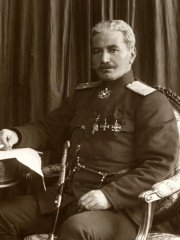
5. Andranik (1865 - 1927)
With an HPI of 69.92, Andranik is the 5th most famous Turkish Military Personnel. His biography has been translated into 41 different languages.
Andranik Ozanian, commonly known as General Andranik or simply Andranik (25 February 1865 – 31 August 1927), was an Armenian military commander and statesman, the best known fedayi and a key figure of the Armenian national liberation movement. He became active in an armed struggle against the Ottoman government and Kurdish irregulars in the late 1880s. Andranik joined the Armenian Revolutionary Federation (Dashnaktustyun) party and, along with other fedayi (militias), sought to defend the Armenian peasantry living in their ancestral homeland, an area known as Western (or Turkish) Armenia—at the time part of the Ottoman Empire. His revolutionary activities ceased and he left the Ottoman Empire after the unsuccessful uprising in Sasun in 1904. In 1907, Andranik left Dashnaktustyun because he disapproved of its cooperation with the Young Turks, the party which years later perpetrated the Armenian genocide. Between 1912 and 1913, together with Garegin Nzhdeh, Andranik led a few hundred Armenian volunteers within the Bulgarian army against the Ottomans during the First Balkan War. From the early stages of World War I, Andranik commanded the first Armenian volunteer battalion within the Russian Imperial army against the Ottoman Empire, capturing and later governing much of the traditional Armenian homeland. After the Revolution of 1917, the Russian army retreated and left the Armenian irregulars outnumbered against the Turks. Andranik led the defense of Erzurum in early 1918, but was forced to retreat eastward due to a threat of encirclement and a lack of food. By May 1918, Turkish forces stood near Yerevan—the future Armenian capital—and were halted at the Battle of Sardarabad. The Dashnak-dominated Armenian National Council declared the independence of Armenia and signed the Treaty of Batum with the Ottoman Empire, by which Armenia gave up its rights to Western Armenia. Andranik never accepted the existence of the First Republic of Armenia because it included only a small part of the area many Armenians hoped to make independent. Andranik, independently from the Republic of Armenia, fought in Zangezur against the Azerbaijani and Turkish armies, and helped to keep it within Armenia. Andranik left Armenia in 1919 due to disagreements with the Armenian government and spent his last years of life in Europe and the United States seeking relief for Armenian refugees. He settled in Fresno, California in 1922 and died five years later in 1927. Andranik is greatly admired as a national hero by Armenians; numerous statues of him have been erected in several countries. Streets and squares were named after Andranik, and songs, poems and novels have been written about him, making him a legendary figure in Armenian culture.

6. Laskarina Bouboulina (1771 - 1825)
With an HPI of 68.46, Laskarina Bouboulina is the 6th most famous Turkish Military Personnel. Her biography has been translated into 32 different languages.
Laskarina Pinotsi, commonly known as Bouboulina (Greek: Λασκαρίνα (Μπουμπουλίνα) Πινότση; 1771 – 22 May 1825), was a Greek naval commander in the Greek War of Independence in 1821, considered one of the first women to attain the rank of admiral. Bouboulina was born in Constantinople in 1771. Her father was Stavrianos Pinotsis, an Arvanite from Hydra and her mother was Skevo Kokkini, descendant of the Byzantine Kokkinis family. During her youth, she developed an interest in sailing which was facilitated by her stepfather's liberal attitude to education. She was widowed twice, inheriting a considerable sum of money from her second husband. She later allegedly joined the Filiki Etaireia secret society which sought to achieve Greek independence from the Ottoman Empire, being among the few women to do so. Following the outbreak of the Greek War of Independence she commanded a fleet of Spetsiot ships which contributed to several campaigns, most notably the siege of Nafplion. Following the defeat of her faction in the Greek civil war in 1824, Bouboulina was briefly imprisoned and expelled to Spetses. She was killed on 22 May 1825, during the course of a family feud. A few days after her death, the Russian Navy awarded her with the honorary title of Admiral, and in 2018 she was awarded the honorary title of Rear Admiral by the Greek Navy.

7. Thomas the Slav (800 - 823)
With an HPI of 68.00, Thomas the Slav is the 7th most famous Turkish Military Personnel. His biography has been translated into 34 different languages.
Thomas the Slav (Greek: Θωμᾶς, romanized: Thōmas, c. 760 – October 823) was a 9th-century Byzantine military commander, most notable for leading a wide-scale revolt in 821–23 against Emperor Michael II the Amorian (r. 820–829). An army officer of Slavic origin from the Pontus region (now north-eastern Turkey), Thomas rose to prominence, along with the future emperors Michael II and Leo V the Armenian (r. 813–820), under the protection of general Bardanes Tourkos. After Bardanes' failed rebellion in 803, Thomas fell into obscurity until Leo V's rise to the throne, when Thomas was raised to a senior military command in central Asia Minor. After the murder of Leo and usurpation of the throne by Michael the Amorian, Thomas revolted, claiming the throne for himself. Thomas quickly secured support from most of the themes (provinces) and troops in Asia Minor, defeated Michael's initial counter-attack and concluded an alliance with the Abbasid Caliphate. After winning over the maritime themes and their ships as well, he crossed with his army to Europe and laid siege to Constantinople. The imperial capital withstood Thomas's attacks by land and sea, while Michael II called for help from the Bulgarian Khan Omurtag. Omurtag attacked Thomas's army, but although repelled, the Bulgarians inflicted heavy casualties on Thomas's men, who broke and fled when Michael took to the field a few months later. Thomas and his supporters sought refuge in Arcadiopolis, where he was soon blockaded by Michael's troops. In the end, Thomas's supporters surrendered him in exchange for a pardon, and he was executed. Thomas's rebellion was one of the largest in the Byzantine Empire's history, but its precise circumstances are unclear due to competing historical narratives, which have come to include claims fabricated by Michael to blacken his opponent's name. Consequently, various motives and driving forces have been attributed to Thomas and his followers. As summarized by the Oxford Dictionary of Byzantium, "Thomas's revolt has been variously attributed to a reaction against Iconoclasm, a social revolution and popular uprising, a revolt by the Empire's non-Greek ethnic groups, Thomas's personal ambitions, and his desire to avenge Leo V." Its effects on the military position of the Empire, particularly vis-à-vis the Arabs, are also disputed.

8. Osman Nuri Pasha (1832 - 1900)
With an HPI of 67.29, Osman Nuri Pasha is the 8th most famous Turkish Military Personnel. His biography has been translated into 29 different languages.
Osman Nuri Pasha (Ottoman Turkish: عثمان نوری پاشا; 1832, Tokat, Ottoman Empire – 4 to 5 April 1900, Constantinople, Ottoman Empire), also known as Gazi Osman Pasha (Turkish: Gazi Osman Paşa), was an Ottoman Turkish field marshal. Being one of the most respected and decorated Ottoman pashas of all time, many songs have been written for him, and many places named after him. This is mainly because he held the Bulgarian town of Plevna for five months against superior Russo-Romanian forces in 1877 during the Russo-Turkish War, though the city eventually fell.

9. Mundus (450 - 536)
With an HPI of 66.88, Mundus is the 9th most famous Turkish Military Personnel. His biography has been translated into 22 different languages.
Mundus or Mundo (Greek: Μοῦνδος; Moundos, Latin: Mundo; died 536) was a Barbarian commander of Gepid, Hun, and/or Gothic origins. He appears to have been the son of the Gepid king Giesmus. In the early 500s he commanded a group of bandits in Pannonia, eventually allying himself to the Ostrogothic king Theodoric the Great. After Theodoric's death in 526, Mundus entered Byzantine service under emperor Justinian I, fighting in the Balkans, defending Justinian during the Nika riots, and fighting in the first stage of the Gothic War, during which he died in 536.
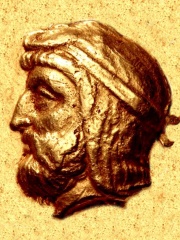
10. Artabazos II (400 BC - 360 BC)
With an HPI of 66.08, Artabazos II is the 10th most famous Turkish Military Personnel. His biography has been translated into 23 different languages.
Artabazos II (in Greek Ἀρτάβαζος) (fl. 389 – 328 BC) was a Persian general and satrap of Hellespontine Phrygia. He was the son of the Persian satrap of Hellespontine Phrygia Pharnabazus II, and younger kinsman (most probably nephew) of Ariobarzanes of Phrygia who revolted against Artaxerxes III around 356 BC. His first wife was an unnamed Greek woman from Rhodes, sister of the two mercenaries Mentor of Rhodes and Memnon of Rhodes. Towards the end of his life, he became satrap of Bactria for Alexander the Great.
People
Pantheon has 38 people classified as Turkish military personnels born between 600 BC and 1954. Of these 38, 1 (2.63%) of them are still alive today. The most famous living Turkish military personnels include Hulusi Akar. The most famous deceased Turkish military personnels include Stilicho, Narses, and Dragut.
Living Turkish Military Personnels
Go to all RankingsDeceased Turkish Military Personnels
Go to all RankingsStilicho
359 - 408
HPI: 74.22
Narses
478 - 574
HPI: 74.06
Dragut
1485 - 1565
HPI: 73.33
Eumenes
362 BC - 316 BC
HPI: 70.85
Andranik
1865 - 1927
HPI: 69.92
Laskarina Bouboulina
1771 - 1825
HPI: 68.46
Thomas the Slav
800 - 823
HPI: 68.00
Osman Nuri Pasha
1832 - 1900
HPI: 67.29
Mundus
450 - 536
HPI: 66.88
Artabazos II
400 BC - 360 BC
HPI: 66.08
Artaphernes
600 BC - 500 BC
HPI: 65.58
Heraclius the Elder
600 - 610
HPI: 65.22
Overlapping Lives
Which Military Personnels were alive at the same time? This visualization shows the lifespans of the 12 most globally memorable Military Personnels since 1700.

